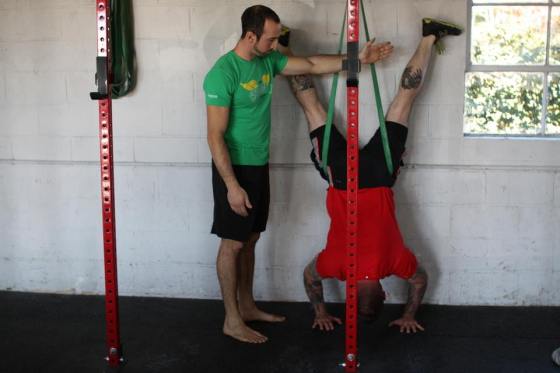With all the pro- and con-CrossFit articles coming out recently (here, here, here, and here), I felt the need to side-step the bullsh*t and just write about what it is that we actually do . . . train.

Practical Tips for Prioritizing Quality over Quantity in a CrossFit Setting
So you’ve been doing CrossFit for some time now, and you have made noticeable gains in your fitness. That’s great! You should take some time to literally stop what you’re doing and reflect on how incredible it is that you are improving your body’s health and capabilities. Getting your first chin-up, muscle-up, or handstand push-up is an accomplishment worth celebrating!
I want to keep things very practical in this article. As you continue to progress in CrossFit, you might reach a point where you find yourself pushing harder and harder to get extra reps and rounds to the detriment of your form and technique. This is not the way to go! Rather, you should prioritize Quality over Quantity so that in the future you may continue to make gains in strength, work capacity, mobility, and overall fitness.
1. Breathe
What a simple thing that we all do everyday! However, mid-WOD, it suddenly becomes apparent that you have not been breathing adequately. How about this: focus on inhaling. Long, slow, controlled, and in through the nose. If you are doing a 20-minute AMRAP, then I want you exclusively breathing through the nose for at least the first 10 minutes. Heavy mouth breathing should be reserved for sprints, short efforts, and the ends of workouts.
2. Break up sets
Have you ever stopped and thought about why 21-15-9 is such an effective rep scheme? One reason is because each set can be broken up into 3 distinct sub-sets: 3 sets of 7, 3 sets of 5, and 3 sets of 3. Another great way to break up this rep scheme is: 11 and 10, 8 and 7, then 5 and 4. So the next time you do Fran, Diane, or Elizabeth, strategize a bit beforehand and see if that helps you set a new PR.
3. Rest between sets
Rest?! Aren’t you supposed to go all out as fast as you can? Okay, yes, I get it, the workouts are done for time. However, you might end up with an overall faster time (and thus greater work capacity) if you actually plan to rest between sets from the get-go. For instance, next time you do Cindy (as many rounds and reps as possible in 20 minutes of 5 pull-ups, 10 push-ups, and 15 squats), try to do 1 round at the top of every minute. If you succeed, you will have accumulated 20 rounds! It will feel very easy in the beginning, and very not-so-easy at the end. (If 20 rounds of Cindy is out of your reach, then try 1 round every 90 seconds. Or, vice-versa, if your old PR is higher than 20, try 1 round every 45 seconds or so.)
4. Prioritize mobility
You know you’re supposed to do it, but somehow you only manage to hit the foam roller or grab that stretch band once or twice a week. How about this: you are not allowed to do a WOD unless you’ve first done your mobility work for the day. Have you ever set a timer for 5 minutes and then rolled out your thoracic spine? Or what about grabbing a lacrosse ball and hitting your entire shoulder girdle? Check out Kelly Starrett’s awesome MobilityWOD project for more ideas.
5. Scale movements and weights effectively
If you only take one principle away from this post, please pay attention here. You want to make optimal choices in your life, correct? If you could take 2 routes to your destination, but one of them was longer and riskier, what would you decide? You would take the optimal route, duh! Similarly, learning to scale movements and weights effectively is how you optimize CrossFit workouts to fit your individual fitness level and needs. Refer to Prilepin’s Chart (a guideline for what percentage of your 1 rep max to lift for each given rep range) when choosing what weights to do for WOD’s:

Thanks for reading! If you have any additional practical tips for how to prioritize quality over quantity in a CrossFit setting, please post to the comments!







